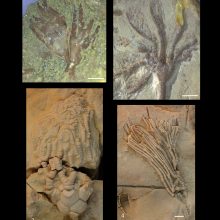Tracking crinoid diversification after the end-Ordovician extinctions in Baltica

The mass extinctions at the end of the Ordovician took out up to 60% of marine genera – the second-most devastating extinction event of the Phanerozoic and the end of the Great Ordovician Biodiversification Event (GOBE). Crinoids were especially hard hit during these global extinctions, and their recovery in the Early Silurian marks the beginning of the Middle Paleozoic Crinoid Evolutionary Fauna consisting mostly of monobathrid camerate, flexible, and eucladid crinoids. Mass extinctions and the ensuing recoveries are global phenomena, thus understanding the paleobiogeographic aspects of these remarkable biodiversity events is needed. Until recently most of the evidence for these crinoid extinctions and faunal recoveries have been in North America on the Laurentia and Avalonia paleocontinents.
Historically, the record of crinoids during the latest Ordovician (Hirnantian) and early Silurian (Llandovery) was virtually unknown. With a concentrated effort by several paleontologists, this gap has been filled for the faunas of Laurentia , but crinoids through this interval had been largely unknown for other paleocontinents. For example, the Baltic paleocontinent has well-known middle Silurian (Wenlock and Ludlow) crinoids from Sweden but not from the critical extinction and recovery intervals. Recent work, including this paper, has extended the record of Late Ordovician (Hirnantian) and early Silurian (Llandovery) crinoid distributions to the carbonate platforms of the Baltica paleocontinent as now exposed in Estonia.
We describe in this article three new Llandovery crinoids from Estonia: Euspirocrinus hintsae (a eucladid), Oepikicrinus perensae (a camerate) and Rozhnovicrinus isakarae, another eucladid. These taxa increase the number of Estonian Llandovery crinoids to eight described species, with another three in open nomenclature. The biogeographic pattern that has emerged shows that the earliest Silurian (Rhuddanian) crinoid radiations on Laurentia, Avalonia and Baltica were derived primarily from existing Ordovician clades from Laurentia. New clades appeared on Laurentia and Avalonia during the following Aeronian, but the clades on Baltica continued from Ordovician roots. By the Wenlock the crinoids on all three paleocontinents were largely from the same cosmopolitan fauna. These biogeographical changes likely tracked the tectonic collision of Baltica with Laurentia in the middle Silurian.
“Early Silurian recovery of Baltica crinoids following the end-Ordovician extinctions (Llandovery, Estonia)” by William I. Ausich, Mark A. Wilson and Ursula Toom has been published in Journal of Paleontology, published by Cambridge University Press on behalf of the Paleontological Society. The article has been made freely available for a limited time.
Read other blog posts from Journal of Paleontology here
or view all blog posts from the Paleontological Society Journals






